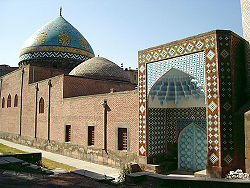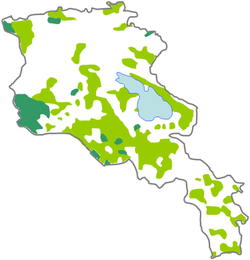Islam in Armenia
History
First Armenian Muslims
Farqad Sabakhi (died 729 AD) was an Armenian Muslim preacher and a companion of Hassan Basri's.[2][page needed] As a result, he is considered one of the Tabi'in (the next generation of companions). Farqad Sabakhi was originally a Christian. Farqad Sabakhi probably raised the famous Karkhi, who played a pivotal role in shaping Sufism. Sabakhi was known for his ascetic life and knowledge of the Judeo-Christian scriptures.[4]
Arab invasions
| Islam by country |
|---|
 |
|
|
The
By the end of the seventh century, the Caliphate's policy toward Armenia and the Christian faith hardened. Special representatives of the Caliph called
Medieval
The Muslim element in Armenia grew progressively stronger during the medieval period. Following the Byzantine defeat at Manzikert in 1071, waves of Turkic nomads making their way from Central Asia and northern Iran penetrated and eventually settled throughout the span of Armenia and Anatolia.[8][9]
Most Ethnic Armenians remained Christian during this period when Western Armenia was divided between Muslim states after the Seljuk invasion. Although some Armenians converted to Islam and became influential members of Beylik society, Armenian architecture influenced Seljuk architecture, and many Armenian Nakharars remained autonomous leaders of Armenian society under Muslim Emirs In Erzincan, Tayk, Sassoun, and Van. The Muslim Emirs intermarried with Armenians, Notably the Shaddadids of Ani who intermarried with Bagratid women. There was an Emir of Van named Ezdin who had Armenian sympathies and was said to be descended from Seneqerim Hovhannes Artsruni, the king of Vaspurakan. The son of Armenian prince Taharten, governor of Erzinjan, His son by a daughter of the emperor of Trebizond converted to Islam and was made governor of erzincan by Timur.[10]
Under Ottoman Empire
The
During the
In the region of
In the early 1500s, the
Periodic forced conversions created a class of
During the
During the Armenian genocide of 1915, many Armenians converted to Islam to escape deportation and massacre.
Under Iranian Empires

The Iranian
As a part of Abbas his
By the time the Iranians had to cede their centuries long suzerainty over Armenia, the majority of the population in what is now Armenia were Muslims. (Persians, Azerbaijani's, Kurds and North Caucasians)
Due to the early
Tsarist period
During the late Tsarist period Muslim populations made up substantial populations in the territory of present-day Armenia. In the Russian Imperial Census of 1897 Muslim populations made up 362,565 of a total population of 829,556 in the Erivan Governorate, which roughly corresponds to modern-day central Armenia, the Iğdır Province of Turkey, and the Nakhchivan exclave of Azerbaijan.[21] 41,417 Tatar Turks, 27,075 Armenians and 19,099 Kurds lived in the Surmalu uezd, part of Turkey today.[21] In the Sharur-Daralayaz uezd, today split across Armenia and Azerbaijan, 20,726 Armenians were likewise outnumbered by the Muslim population, consisting of 3,761 Kurds and 51,560 Tatars.[21] With the influx of Armenian refugees in the aftermath of the Armenian genocide, the demographic balance shifted in favor of Armenian populations.
First Republic of Armenia
The government of the First Republic of Armenia pursued a policy of ethnic homogenisation in favour of Armenians in the areas under its control. In 1917–1921, Muslims in Armenia were subject to largescale massacres and deportations orchestrated by Armenian partisans, leading to the destruction of dozens of Muslim settlements, killings of thousands of Muslim civilians and the displacement of as many as 235,000.[22][23]
The governance of Armenia was undermined by large-scale
Soviet period
With the historical provinces being subsumed within the borders of the
Independent Armenia
Since Armenia gained its independence in 1991, the majority of Muslims still living in the country are temporary residents from Iran and other countries. In 2009, the Pew Research Center estimated that 0.03%, or about 1,000 people, were Muslims – out of total population of 2,975,000 inhabitants.[27][28]
Population census conducted in 2011 counted 812 Muslims in Armenia,[29] the majority of which were from Iran.[30]
Cultural heritage

A significant number of mosques were erected in historical Armenia between the Middle Ages and the Modern age[citation needed], though it was not unusual for Armenian and other Christian churches to be converted into mosques, as was the case, for example, of the Cathedral of Kars, Cathedral of Ani, and Holy Mother of God Church in Gaziantep.
The Blue Mosque of Yerevan is the only active mosque in Armenia today, having been restored and opened for religious services in cooperation between Armenian and Iranian authorities following the collapse of the Soviet Union.[31] In 2022, plans were announced in cooperation between Iranian authorities and the Yerevan municipality to renovate the Abbasqoli Khan Mosque (also known as the Thapha Bashi moque), an old mosque in ruins, located in the Kond quarter of Yerevan.[32]
The Qur'an
The first printed version of the Qur'an translated into the Armenian language from Arabic appeared in 1910. In 1912 a translation from a French version was published. Both were in the Western Armenian dialect. A new translation of the Qur'an in the Eastern Armenian dialect was started with the help of the embassy of the Islamic Republic of Iran located in Yerevan. The translation was done by Edward Hakhverdyan from Persian in three years.[33] A group of Arabologists have been helping with the translation. Each of the 30 parts of Qur'an have been read and approved by the Tehran Center of Qur'anic Studies.[34] The publication of 1,000 copies of the translated work was done in 2007.
Notable Armenian Muslims
- Farqad Sabakhi
- Mohammad Beg
- Qarachaqay Khan
- Ali ibn Yahya al-Armani
- Badr al-Jamali
- Al-Afdal Shahanshah
See also
- Religion in Armenia
- History of Armenia
- Hamshenis
- Emirate of Armenia
- Iranian Armenians
References
- ^ "Religious Composition by Country, 2010-2050". Pew Research Center. 12 April 2015. Retrieved 22 October 2017.
- ^ a b Ter-Ghewondyan, Aram (1976). The Arab Emirates in Bagratid Armenia. Trans. Nina G. Garsoïan. Lisbon: Calouste Gulbenkian Foundation.
- ^ Vryonis, Speros (1971). The Decline of Medieval Hellenism in Asia Minor and the Process of Islamization from the Eleventh through the Fifteenth Century. Berkeley: University of California Press.
- ^ Historical dictionary of Sufism By John Renard, pg. 87
- ^ Kurkjian, Vahan M.A History of Armenia hosted by The University of Chicago. New York: Armenian General Benevolent Union of America, 1958 pp. 173-185
- ^ On the Arab invasions, see also (in Armenian) Aram Ter-Ghewondyan (1996), Հայաստանը VI-VIII դարերում [Armenia in the 6th to 8th centuries]. Yerevan: Armenian Academy of Sciences.
- ^ Ter-Ghevondyan, Arab Emirates in Bagratid Armenia, pp. 29ff.
- ^ Cahen, Claude (1988). La Turquie pré-ottomane. Istanbul-Paris: Institut français d’études anatoliennes d’Istanbul.
- ^ Korobeinikov, Dimitri A. (2008). “Raiders and Neighbours: The Turks (1040-1304),” in The Cambridge History of the Byzantine Empire, c. 500‐1492, ed. Jonathan Shepard. Cambridge: Cambridge University Press, pp. 692-727.
- ^ "Armenia during the Seljuk and Mongol Periods".
- ^ McCarthy, Justin (1981). The Ottoman Peoples and the End of Empire. New York: Oxford University Press, p. 63.
- ISBN 1-4039-6422-X.
- ^ (in Armenian) Zulalyan, Manvel. "«Դեվշիրմեն» (մանկահավաքը) օսմանյան կայսրության մեջ ըստ թուրքական և հայկական աղբյուրների" [The "Devshirme" (Child-Gathering) in the Ottoman Empire According to Turkish and Armenian Sources]. Patma-Banasirakan Handes. № 2-3 (5-6), 1959, pp. 247-256.
- ISBN 9780203641682.
- ^ http://ysu.am/files/1-1512129568-.pdf [bare URL PDF]
- ^ a b c http://www.fundamentalarmenology.am/datas/pdfs/292.pdf [bare URL PDF]
- ^ "Alevized Armenians in Dersim". Western Armenia TV. 6 March 2017. Retrieved 2022-04-04.
- ^ "Untitled".
- ISBN 978-0520097926p 39
- ^ http://shsu.am/media/journal/2013n2b/7.pdf [bare URL PDF]
- ^ a b c Leupold, David (2020). Embattled Dreamlands. The Politics of Contesting Armenian, Turkish and Kurdish Memory. New York: Routledge. pp. 93–94.
- ISBN 978-0520041868.
- ISBN 978-0520088030.
- ^ Bechhofer Roberts, Carl Eric (1921). In Denikin's Russia And The Caucasus, 1919-1920: Being A Record Of A Journey To South Russia, The Crimea, Armenia, Georgia, And Baku In 1919 And 1920. p. 263.
[On] the Igdir front … General Sebo [Sebouh] was holding the Kurds at bay. … [T]owards Ararat … was the Kamarloo [Artashat] front. There the enemy was the Tartar, supported, of course, by Turkish auxiliaries and excited by their agents. Far away in the East is the way to Nahichevan, which was in the possession of the enemy.
- ^ Somakian, Manough Joseph (1992). Tsarist and Bolshevik Policy Towards the Armenian Question 1912-1920 (PDF). London: University of London. p. 311. Archived from the original (PDF) on 25 July 2022.
By the summer of 1919, the question of repatriation was completely overshadowed by widespread Muslim uprisings. The issues at stake had transformed the repatriation question into a matter of Armenian survival.
- ^ a b "Gefährliche Töne im "Frozen War"." Wiener Zeitung. 2 January 2013.
- ^ Miller, Tracy, ed. (October 2009), Mapping the Global Muslim Population: A Report on the Size and Distribution of the World's Muslim Population (PDF), Pew Research Center, p. 31, archived from the original (PDF) on 2009-10-10, retrieved 2009-10-08
- ^ "2011 Census data" (PDF). p. 7.
- ^ Media, Ampop (2017-12-26). "Կրոնական կազմը Հայաստանում | Ampop.am". Ampop.am. Retrieved 2018-01-25.
- ^ Karamyan, Sevak; Avetikyan, Gevorg (2022). "Armenia (Vol 13, 2020)". In Müssig, Stephanie; Račius, Egdunas; Akgönül, Samim; Alibašić, Ahmet; Nielsen, Jørgen S.; Scharbrodt, Oliver (eds.). Yearbook of Muslims in Europe Online. Brill Online.
- ^ "Armenian Premier Receives Iranian Delegation". Daily Report: Soviet Union (35–39). Foreign Broadcast Information Service: 103–104. 22 February 1991.
The guests had a businesslike meeting at Yerevan city soviet executive committee where an agreement was drafted to repair the capital's 17th century Persian architectural edifice, the Blue Mosque. In keeping with the agreement, Iran will send renovation specialists to Yerevan and will provide the necessary amount of construction material. Plans are to complete the renovation work before 1995.
- ^ "Iran ready to help restore Yerevan mosque". Tehran Times. 2022-09-13. Retrieved 2022-11-27.
- ^ The Qur'an is published in the Armenian language Archived 2007-05-10 at the Wayback Machine
- ^ Qur'an in Armenian Archived 2007-02-10 at the Wayback Machine
